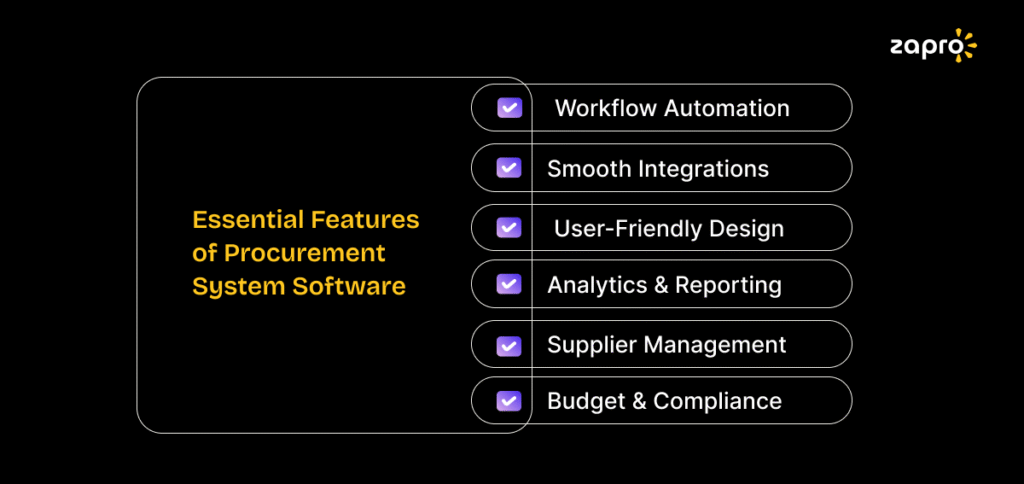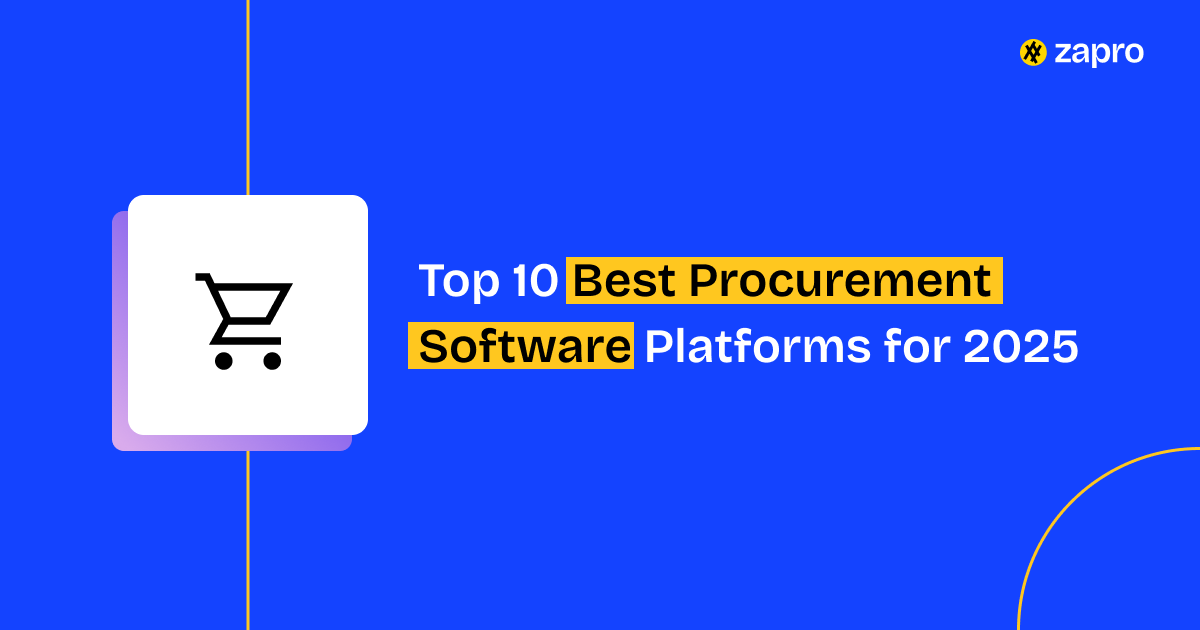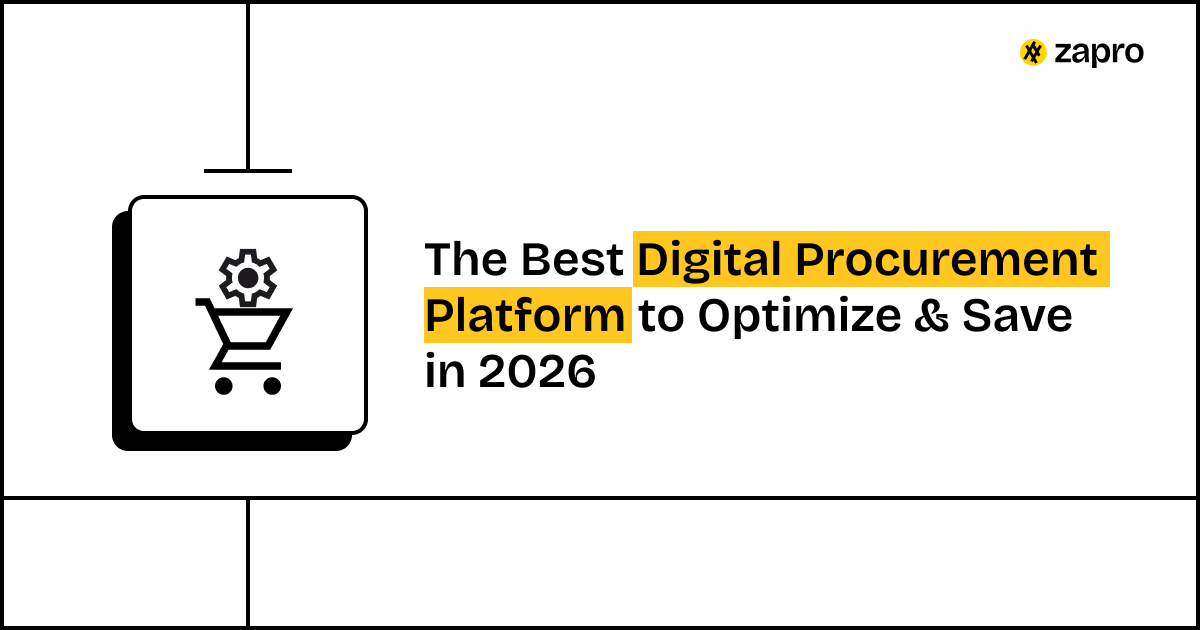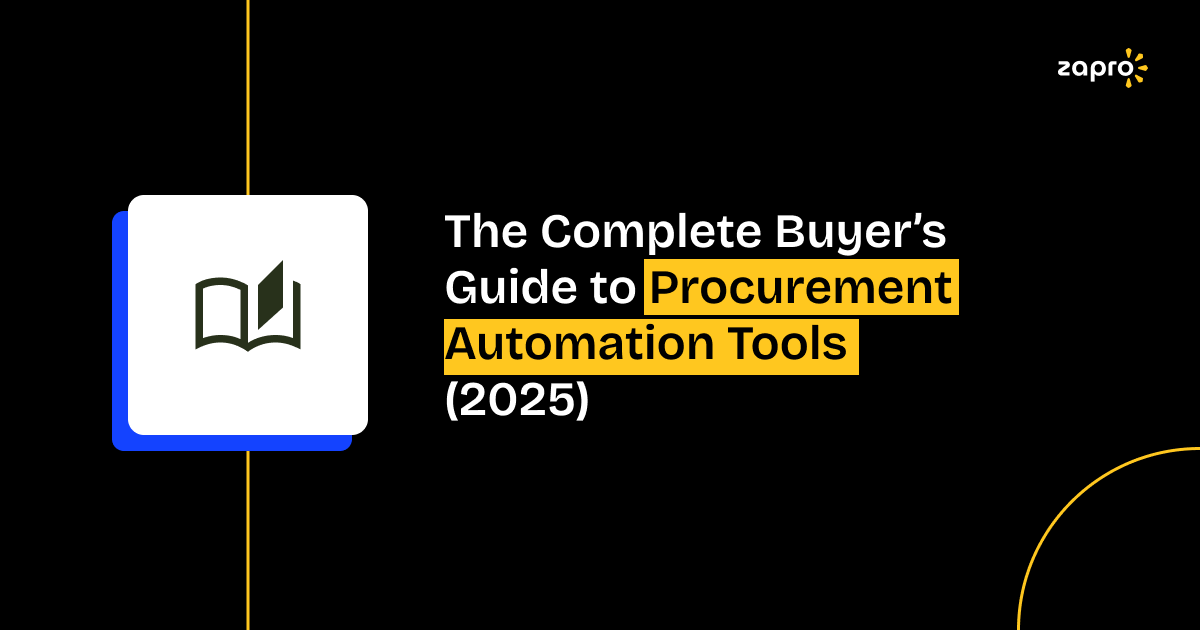Are you looking for the best procurement software that will make your business operations easier?
It’s a fact that you are in the right place. One of the ways to manage a growing business is by using tools that save time, eliminate unnecessary costs, and help your team work more efficiently. Without a doubt, procurement software is one of these tools. It simplifies purchasing, ensures that your supplier relationships are well managed, and enables you to have total visibility of your expenditures, all at the same time, it lessens manual work and expensive errors.
By reading this blog, you get to know about a carefully selected list of the best procurement tools, which can be a great source of business transformation by handling purchasing in a new way. Continue reading to find out how these platforms can be of great help to you in building a procurement process that is smoother, quicker, and more efficient for your organization.
The top procurement software platforms in 2026 include Zapro, SAP Ariba, Coupa, Oracle Procurement Cloud, and Ivalua, recognized for their robust sourcing, spend management, and automation capabilities. These tools help businesses streamline purchasing, enhance supplier collaboration, and ensure compliance across the procurement lifecycle. Each platform offers unique strengths suited for different business sizes and industries.
What is the best procurement software for businesses in 2026?
The best procurement software in 2026 depends on your business size, budget, and workflow needs — but Zapro is one of the top picks. It combines AI‑powered spend analytics, automated workflows (POs, invoices, approvals), vendor management, and risk compliance all in one simple, scalable platform.
Learn about digital procurement platform.
Top 10 Best Procurement Software Platforms for 2026
Here are the 10 Best Procurement Software Platforms for 2026:
- Zapro
- SAP Ariba
- Coupa
- Oracle Procurement Cloud
- Jaggaer
- GEP SMART
- Ivalua
- ProcurementExpress.com
- Precoro
- Kissflow Procurement Cloud
1. Zapro
Outline: Zapro operates as a modern procurement system software which simplifies the process of approval management and supplier interaction and intake procedures. The platform uses AI automation to help procurement teams automate their repetitive work while improving compliance and delivering immediate spend visibility. The platform operates from the cloud which enables businesses of all sizes to expand their operations.
Key Features: Guided intake, predictive spend analytics, SLA tracking, AI-driven compliance, cloud-native scalability.
Pricing: Flexible, request-based.
Perfect for: The platform serves businesses of all sizes from small to large enterprises which need a basic yet effective procure-to-pay solution. The AI capabilities of this tool benefit organizations that seek to automate their procurement operations through minimal human involvement during modernization efforts.
Pros:
- Intuitive design with fast adoption
- Strong AI automation and insights
- Scales easily across global operations
Cons:
- Pricing details available only on request
Simplify Procurement, Maximize Efficiency

2. SAP Ariba
Outline: SAP Ariba maintains its position as a top digital sourcing platform and procurement solution for businesses. The platform offers complete spend management and supplier engagement and contract lifecycle governance features which make it suitable for complex global enterprises.
Perfect for: The platform provides its best performance for organizations that handle numerous suppliers throughout different geographic areas. Organizations with complex procurement operations that need extensive supplier network management should consider Ariba as their primary solution.
Pros: Scalable, global supplier network
Cons: Complex implementation, higher cost
3. Coupa
Outline: Coupa outshines competitors through its powerful procurement analytics and complete organizational spending visibility. The platform provides detailed reports and user-friendly interface which enables organizations to make better choices while keeping costs under control.
Perfect for: The platform suits organizations which base their procurement operations on cost management and operational excellence. The reporting capabilities of Coupa enable finance and procurement leaders to link their spending activities to organizational business objectives.
Pros: Excellent reporting, user-friendly
Cons: Pricing may be high for SMBs
Learn more about Zapro vs Coupa
4. Oracle Procurement Cloud
Outline: The procure-to-pay system of Oracle Procurement Cloud provides complete functionality through its seamless integration with Oracle’s ERP suite. The system provides sophisticated compliance tools and complete spend management capabilities which make it suitable for businesses operating within the Oracle environment.
Perfect for: The system provides optimal performance for organizations using Oracle ERP systems because it connects directly to their current operational workflows. The system requires extensive training because it operates at a more complex level than basic procurement solutions.
Pros: Deep ERP integration, advanced compliance
Cons: Steep learning curve
5. Jaggaer
Outline: The digital sourcing platform of Jaggaer uses AI technology to deliver advanced supplier management and analytics capabilities. The system provides solutions to manage extensive procurement operations and manage complex supplier networks.
Perfect for: The platform serves organizations that operate globally with suppliers from different backgrounds best. The platform enables organizations to optimize their sourcing operations through data-driven insights which enhance supplier relationships.
Pros: Advanced analytics, strong sourcing tools
Cons: UI can feel dated
6. GEP SMART
Outline: The cloud-based procurement software GEP SMART uses artificial intelligence together with analytics to help users make better decisions. The platform unifies procurement functions with supply chain management through a single solution which differentiates it from other industry competitors.
Perfect for: Enterprises seeking a mobile-first platform which manages extensive procurement and supply chain operations through one system should choose this solution. The system requires customization for smaller businesses to achieve complete alignment with their operational needs.
Pros: AI-driven, mobile-first
Cons: May require customization for SMBs
7. Ivalua
Outline: Ivalua stands out because it provides flexible solutions that match the unique needs of different procurement operations. The platform features high customization options which enable businesses to create workflows that match their internal procedures exactly.
Perfect for: The software serves organizations that need customized procurement solutions because standard solutions fail to meet their complex requirements. The system provides powerful functionality although its implementation process extends beyond basic systems.
Pros: Highly customizable
Cons: Longer implementation time
8. ProcurementExpress.com
Outline: The procurement software at ProcurementExpress.com provides simple functionality which makes it suitable for organizations seeking procurement solutions without complicated learning processes. The system enables fast implementation and enables small teams to handle approval and purchase management.
The platform offers its best functionality to small and medium businesses that require an easy-to-use procurement solution at budget-friendly prices. The system provides fast performance and user-friendly interface but lacks the capacity to support extensive large-scale organizations.
Perfect for: The platform works best for small to medium businesses that expand their operations while requiring a system to track expenses effectively. The platform delivers solid core procurement management yet it does not provide sophisticated sourcing capabilities for demanding procurement needs.
Pros: Affordable, fast setup
Cons: Limited scalability
9. Precoro
Outline: The budget-friendly procurement platform Precoro provides effective purchase order and approval management at an affordable price. The system supports growing businesses to track expenses while maintaining clear documentation of their operations.
Perfect for: The platform serves small to medium businesses that expand their operations because it provides effective spend tracking capabilities. The platform delivers solid performance for standard procurement needs but it does not support complex sourcing operations.
Pros: Easy to use, strong spend tracking
Cons: Limited advanced sourcing tools
10. Kissflow Procurement Cloud
Outline: Kissflow Procurement Cloud provides organizations with a flexible procure-to-pay system that includes no-code workflow automation capabilities. The platform allows users to create procurement workflows that align with their business operations through its flexible customization features.
Perfect for: The software serves businesses in the mid-market segment which need customizable workflows without requiring advanced technical knowledge. The platform delivers affordable value to customers although it lacks advanced features that large enterprises require.
Pros: Customizable workflows, good value
Cons: May lack deep enterprise-level features
Learn more about Top Affordable Purchasing Software for Small Businesses in 2026

The global procurement software market is projected to grow from USD 7.9 billion in 2025 to USD 21.9 billion by 2035, at a CAGR of 9.7%.
— Future Market Insights, Procurement Software Market Size, Demand & Forecast 2025 to 2035
Best Procurement Software Comparison Table:
| Platform | Starting Price | Key Features | Best For | Integrations |
| Zapro.ai | Request pricing | AI automation, SLA tracking, spend insights | SMBs & Enterprises | ERP, Finance, HR |
| SAP Ariba | Custom pricing | Global supplier network, sourcing | Large Enterprises | SAP ERP |
| Coupa | Custom pricing | Spend visibility, analytics | Enterprises | ERP, Accounting |
| Oracle Procurement Cloud | Custom pricing | Procure-to-pay, ERP integration | Oracle users | Oracle ERP |
| Jaggaer | Custom pricing | AI sourcing, supplier management | Global Organizations | ERP, CRM |
| GEP SMART | Custom pricing | Cloud-native, AI-driven | Enterprises | ERP, Finance |
| Ivalua | Custom pricing | Configurable workflows | Complex industries | ERP, HR, Finance |
| ProcurementExpress.com | $35/user/month | Simple PO management | SMBs | QuickBooks, Xero |
| Precoro | $35/user/month | Budget tracking, approvals | SMBs | ERP, Accounting |
| Kissflow Procurement Cloud | Custom pricing | No-code automation, flexible P2P | Mid-size companies | ERP, HR, Finance |
Learn about Best Purchase Order Software of 2025
Essential Features Every Business Needs in the Best Procurement Software

Choosing the right procurement system software isn’t just about ticking boxes, it’s about finding a solution that makes life easier for your team while driving real business results. The features that are important are as follows:
- Procurement workflow automation: Eliminate the need for human-intervention for the tasks such as writing emails, follow ups, and maintaining spreadsheets. Automate procurement workflow, effortlessly manage intake, approvals, and PO software creation save time and reduce costly errors.
- Smooth integrations: Pick the right procurement software that would be able to establish connection with ERP, Accounting, and HR systems simultaneously and function free of hassle.
- User-friendly design: Check for user-friendly designs that work best for the teams. The software should be easy to use and should not challenge how to work on it; otherwise, the purpose remains unattended. Therefore, pick the ones with intuitive designs, mobile access, so that your team members can check and revert on the go.
- Procurement analytics and reporting: Collect and analyze valuable procurement data to gain business insights and inform decision-making with ease.
- Supplier management tools: Store in one place and restrict access to data pertaining to vendors, supplies, contracts, etc.,. This helps building long lasting relationships and trust with vendors.
- Budget control and spend visibility: By tracking every minute details real-time, maintain within the budget limits. Avoid wasted spending surprises at the end of the month. Get clear and accurate insights.
- Compliance and approval workflows: Go for automated compliance and approvals to keep your procurement risk-free and scalable. Ensure the software is able to provide every detail like in the time audit-checks.
- Digital sourcing platform capabilities: Your procurement system should also manage sourcing events, RFPs, and negotiations, giving you full control of the entire cycle.
Learn about best procure to pay software.
Choosing the Right Procurement Software for Your Business
There are numerous procurement tools available in the market, but the right choice for you basically depends on understanding your business in terms of size, processes, and how complicated its purchasing needs are.
In case you are a big company with multiple suppliers, compliance requirements, and global operations to manage, then platforms like SAP Ariba, Coupa, GEP Smart, and Jaggaer would be the best solutions to offer the required depth and automation for the seamless flow of operations. These instruments are perfect when it comes to advanced sourcing, supplier collaboration, and AI-powered insights.
Midsize firms that want to increase their productivity without burdening their teams may find the likes of Precoro, Procurify, and Kissflow as a perfect option. These solutions are simple to implement, users quickly get the hang of them, and they are designed to streamline procurement processes without a complicated tutorial.
If an organization desires the procurement process to be closely connected with maintenance and asset management, then Azzier CMMS is the right choice as it offers a great combination of purchasing, inventory control, and equipment management in one system.
The best procurement software is essentially the one that aligns with your objectives, whether it be saving money, speeding up the approval process, increasing visibility, or getting rid of manual work. Identify your problem areas, list your priorities, and then pick a platform that gives you the perfect mix of scalability, functionalities, and integration with your current tools without any hassle.
Future of Procurement Technology
Digital Sourcing Platform Trends to Watch in 2026
AI and machine learning are about to get wild—think software that predicts what you’ll need before you even know you need it. Less guesswork, more “whoa, how’d it know that?”
Sustainability’s not just a buzzword anymore. Tools are popping up to track all that ESG and carbon footprint stuff, so you can brag about being green—and actually back it up.
Analytics are getting way smarter, too. Like, real-time spend forecasts instead of waiting ages for a report. It’s basically procurement with a crystal ball.
And mobile? If you can’t approve stuff from your phone while you’re waiting for coffee, what are we even doing here? Expect more on-the-go features, ‘cause nobody wants to be chained to their desk.
In simple terms, this is what is the future of procurement technology, AI and machine learning, Sustainability tracking, Advanced procurement analytics, Mobile-first procurement, Blockchain for transparency.
Key takeaways
- A best procurement software solution integrates all essential functions including sourcing, purchasing, vendor management, contract handling, and analytics capabilities into one platform.
- The implementation of automation technology removes human involvement from processes while decreasing mistakes and shortening the time needed for approval procedures.
- The combination of real-time spend tracking and dashboard analytics enables procurement teams to base their decisions on actual data.
- The implementation of strong integration capabilities between ERP systems, finance, and inventory management platforms creates efficient workflow operations.
- Modern procurement tools require AI-based features which include forecasting and anomaly detection capabilities.
- The software needs to scale up and adapt to your business growth through customization features.
- Security measures, together with compliance standards and audit trail functionality, protect procurement operations from threats.
- The selection of an appropriate procurement Software requires organizations to evaluate how well the system matches their operational needs, user requirements, and financial constraints.
Conclusion
The best procurement software for your business will give you end to end visibility, identify spends, pick right suppliers, and increase compliance. The procurement software scales up the processes and does away with manual intervention, paper work, follow ups, and poor visibility. Click on the go to find all the details in one smart dashboard and effectively identify ways to reduce costs, and risks.
Zapro.ai ranks in the top 5 procurement software companies offering a whole load of features and customization options to businesses that want to set-it up for procurement process streamlining. Nevertheless, the AI-powered workflow automation, unbeatable design style, and global scalability make it a better choice for businesses of all sizes around the globe.

Stop Wasting Time on Manual Procurement
Automate procurement with AI. Real-time approvals. Complete visibility.
FAQs
1. What is procurement software and why do businesses need it?
Procurement software is a business software that allows enterprises to automate their entire source-to-pay cycle. It automates every-bit manual process behind procurement from sourcing, to vendor management. Besides this, it helps in minimizing unwanted expenses, improving the overall efficiency, and increasing compliance for the business.
2. What is procurement system software?
Procurement system software is a digital platform that automates and manages the purchasing process from requisition to payment. The software streamlines vendor selection, purchase order creation, approval workflows, and spending analysis. Organizations use procurement systems to reduce costs, improve compliance, and gain visibility into their purchasing activities.
3. What are the key features to look for in procurement workflow automation?
Procurement software can be more beneficial for organizing a lot of things in the firm, and those benefits come of great help when you pick procurement management software that offers advanced options. Make sure these features of procurement software are there on your list: accounting automation, curation options, flexible workflows, intuitive design, and integrations.
4. How long does it take to implement procurement software?
An implementation of procurement software can take anywhere from a few weeks to several months, this is going to depend on the company size, customization requirements, and integrations. In every case, ensure the teams are informed, how they are informed, and post implementation, have a plan ready to go with the training sessions.
5. Which procurement software is best for small and medium businesses?
While there are numerous procurement software available in the market now, we recommend you take the Zapro.ai software for your company. From demo through implementation and post implementation support, we provide you with the best service that is available now in the market.
6. What makes a digital sourcing platform different from traditional procurement software?
Technology has overtaken the hiccups and roadblocks which affected the process in a big way – from paper work, manually managing the function, attending and making calls to people, to lack of visibility. However the digital sourcing platform provides us with a web based infrastructure of the supply chain and purchasing activities and systems. It works beyond purchasing, managing RFPs, negotiations, and supplier scoring with AI-powered insights.
Don’t miss our weekly updates
We’ll email you 1-3 times per week—and never share your information.

 Healthcare
Healthcare Financial Services
Financial Services Technology
Technology Venture Capitalist
Venture Capitalist Chief Procurement Officer
Chief Procurement Officer Chief Financial Officer
Chief Financial Officer




